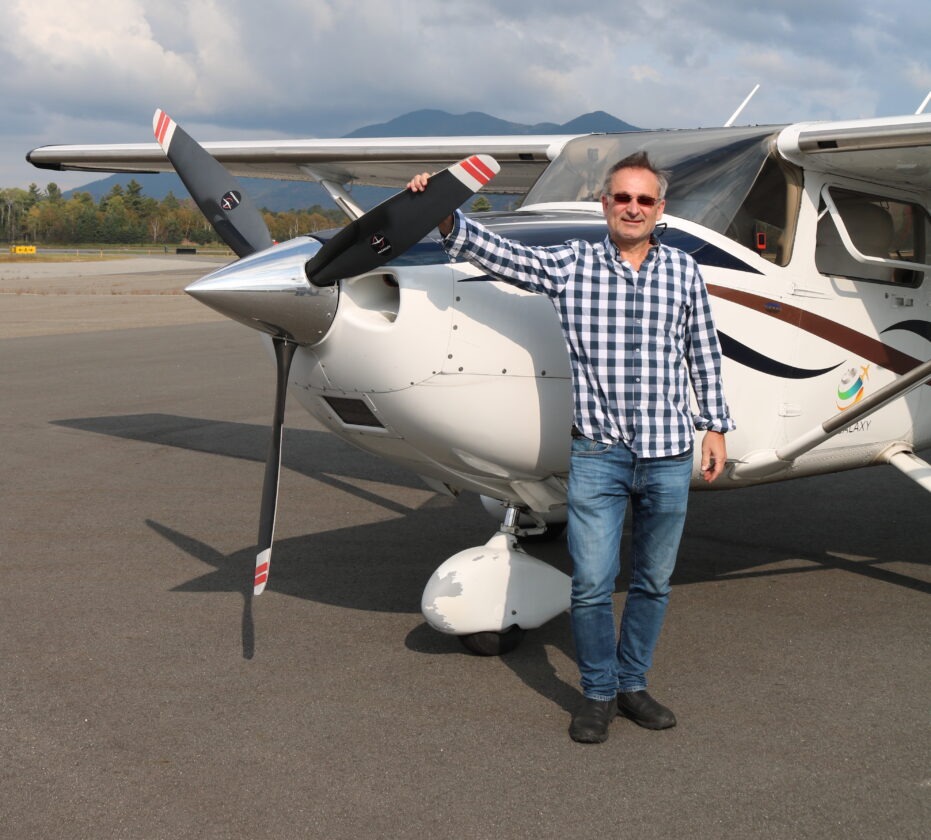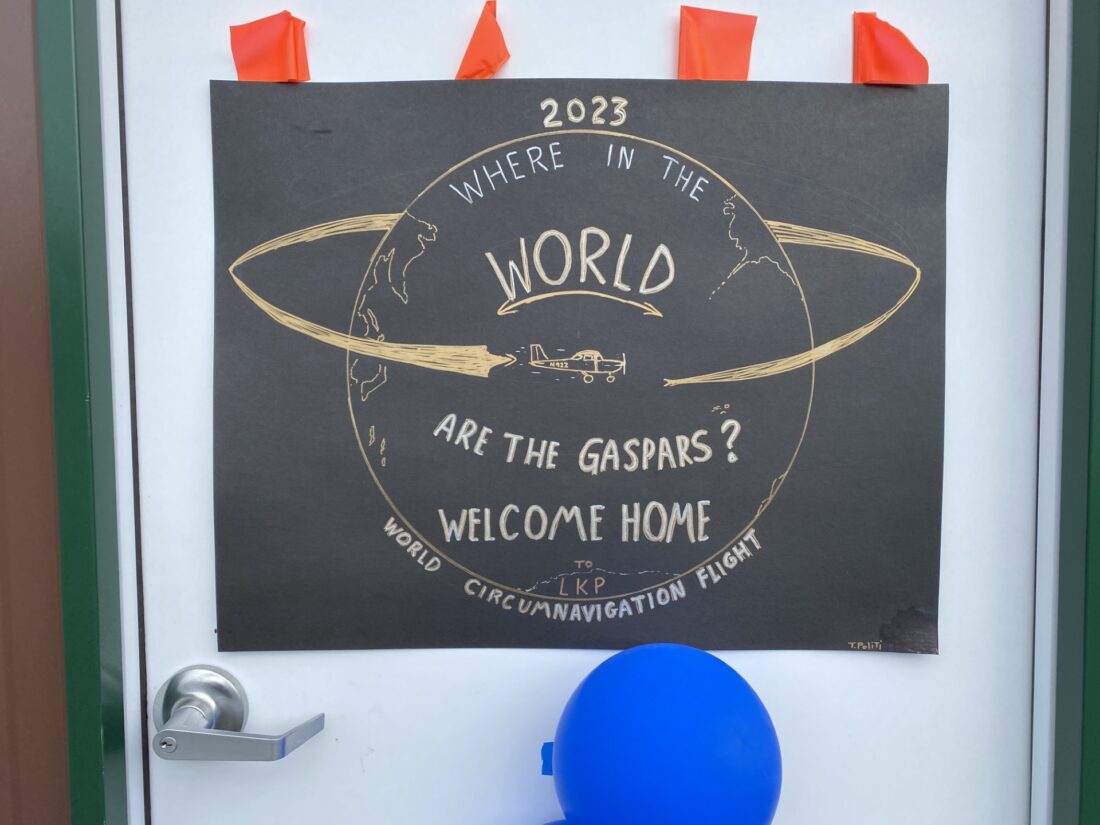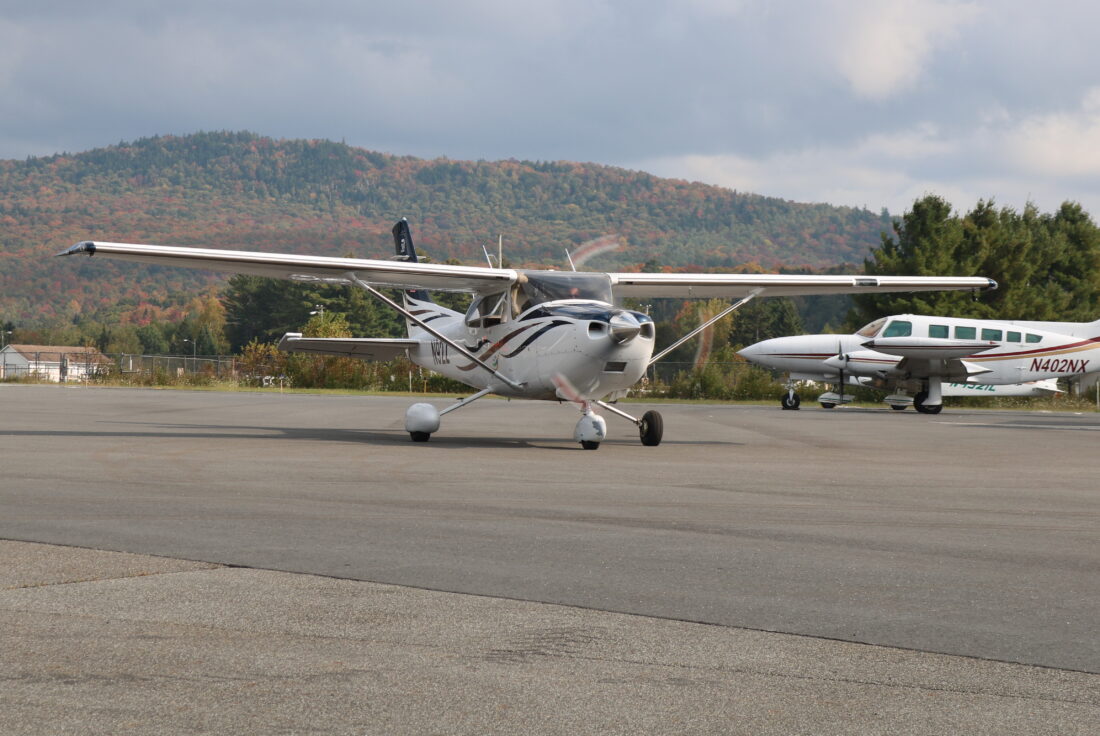Where in the world are the Gaspars?
Lake Placid couple circumnavigates the globe
- Yuri Gaspar poses with his Cessna 182, “Skylane,” Monday, Sept. 25 immediately after completing his 24,000-mile-long flight around the globe. He and his wife departed Lake Placid for their first stop, Greenland, on May 27. (News photo — Sydney Emerson)
- Yuri Gaspar’s Cessna 182 taxis over to the hangar at Lake Placid Airport Monday, Sept. 25 shortly after completing a circumnavigational flight of the planet. (News photo — Sydney Emerson)
- Pilots at Lake Placid Airport kept tabs on the Gaspars’ journey around the globe for the past four months. (News photo — Sydney Emerson)

Yuri Gaspar poses with his Cessna 182, “Skylane,” Monday, Sept. 25 immediately after completing his 24,000-mile-long flight around the globe. He and his wife departed Lake Placid for their first stop, Greenland, on May 27. (News photo — Sydney Emerson)
LAKE PLACID — When Yuri Gaspar touched down at Lake Placid Airport on Monday, Sept. 25, he was greeted with applause, balloons and champagne after a trip around the world.
His single-engine Cessna 182, “Skylane,” took off from the same runway on May 27 headed for Greenland. Once he and his wife, Sylva, reached their destination, they decided to keep heading east at their own pace. By September, it was clear that they were going to complete a rare feat: a circumnavigation of the planet.
“(Circumnavigation) was always, like, in the back of my mind — a dream, if I can make it” Gaspar said. “We just took it easy, one step at a time.”
Gaspar, 56, lives in Lake Placid, where he is an attorney. Originally from Czechoslovakia — now Slovakia — he moved to Lake Placid with his family from Long Island after the Sept. 11, 2001 attacks. He learned to fly at the Lake Placid Airport in 2005, instructed by Terry Politi. Now, upon completing his circumnavigation, he joins an elite club of around 1% of pilots, according to Lake Placid Airways owner Russ Francis.
“There are very, very few people on the planet that, A, can do this; B, have the skills to organize it and plan it; and then C, the most important part, is to actually carry out the plan or make the plan up as you go along … and execute it properly,” Francis said. “At any point in time, it’s over. You go through Abu Dhabi and they don’t like the fact that you’re American or Czechoslovakian or Hawaiian, and you’re not going to go anywhere. You’re going to go either without your plane or without your life. And that’s a very, very real part of traveling.”

Pilots at Lake Placid Airport kept tabs on the Gaspars’ journey around the globe for the past four months. (News photo — Sydney Emerson)
According to Earthrounders, a self-reporting register of pilots who have circumnavigated the Earth, there have been 246 circumnavigational flights completed in single-engine aircrafts as of 2022. The first was 99 years ago in 1924 and was completed in 175 days. Gaspar finished his trip in 121 — he and his wife took time to sightsee in many of their destinations. As of Monday, he had not combed the flight logs to calculate final statistics for the trip, but he estimates their trip covered around 24,000 miles, through 25 countries and more than 220 hours in the cockpit.
“It was a very nice way to travel because there is no jetlag,” Gaspar said, adding that he didn’t experience jetlag until he crossed the International Date Line in the Pacific Ocean.
The Gaspars did not plan their route in advance. Rather, when planning their next stop, they considered where they wanted to visit and the feasibility of landing there. Small private planes need a permit to land in every country, some of which are hard to acquire. Additionally, some countries do not keep supplies of avgas — that’s aviation gasoline, which is used for small crafts like Gaspar’s — making flight plans all the more complicated.
“It was difficult to plan the route because of the avgas,” Gaspar said. “There is no general aviation like we know (in the U.S.) anywhere in the world. A little bit in the UK, a little bit in Europe. … The rest is just commercial airlines and military, and they don’t have small planes, so they don’t have avgas. So, to get the avgas, it was like the worst thing.”
One of the Gaspars’ most memorable landings was in Karachi, the largest city in Pakistan.

Yuri Gaspar's Cessna 182 taxis over to the hangar at Lake Placid Airport Monday, Sept. 25 shortly after completing a circumnavigational flight of the planet. (News photo — Sydney Emerson)
“This was one of the places I was a little bit worried about,” he said. “What are they going to do with an American airplane? So, we land in Pakistan, which was pre-arranged. You cannot just go there. And then there are buses coming — two buses, like military buses, to our plane, and soldiers running out with the automatic (guns). They circled the plane, and there’s probably about 12 soldiers. I’m still inside, and I say, ‘What’s going to happen?’ And then the handler comes and waves that (we) can get out.
“So, I open the door, getting out, and my wife got out on the other side. And (he said) ‘Oh, welcome to Karachi, Pakistan. You made it.’ And I said, ‘What is this all about here?’ He said, ‘They’re here to protect your plane. Don’t worry. To protect you and your plane.’ And they assigned bodyguards, one for me and one for my wife. … We spent three days (in Karachi), we came back and the soldiers were there 24 hours guarding the plane.”
Gaspar’s Cessna had, when he left Lake Placid, a single fuel tank. It could fly for six or seven hours before refueling, and this system worked for the majority of his trip. When it came time to cross the Pacific, however, he had some tough decisions to make. A Pacific crossing in a Boeing 747 can take upwards of 11 hours, depending on the destination. In a small single-engine craft, this will take even longer — more than twice the fuel capacity of Gaspar’s plane.
“The biggest problem that we were trying to figure out is, when (Gaspar) got to Japan, where (was he) going to go?” Politi said. He made a hobby of checking on Gaspar’s flight path daily.
“We’re thinking, OK, well you’re not going to make it to the Aleutians. What are you going to do? You’re not going to retrace your steps all the way back. Maybe you’re going to take the plane apart and ship it over; sell it and take airlines home and buy a new one when you got here.”
Anxiety mounted at Lake Placid Airport when Politi reported that Gaspar’s Cessna was setting out over the Pacific.
“When (Gaspar) started southeast out of (Japan) and then turned north, (Terry) got really, really concerned,” Francis said. “He goes, ‘Wait a second, that’s not — he can’t go that far.’ He was there every minute.”
Unbeknownst to his followers back home, Gaspar had a second fuel tank installed while he was in Japan — enough to get him across the Pacific. Flying solo — his wife had to bow out of the trip in Japan to be with her father, who was hospitalized — he crossed the Pacific in a little over 12 hours, flying from Japan to Alaska. Everybody following along in Lake Placid was relieved to see that Gaspar landed safely.
“All of us who have flown for any length of time … were following you every single step of the way, living something that we’d all love to try and do through your trip, Francis said.
As for his future travel plans, Gaspar has nothing on the horizon.
“Nothing for now, no,” he said. “I have to go and pay my bills and work to do that.”




